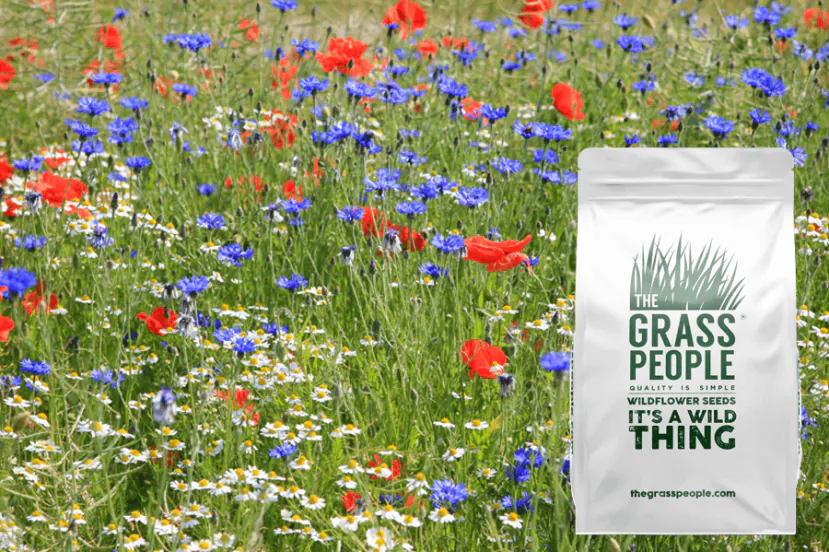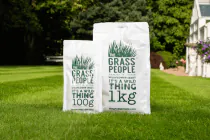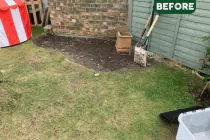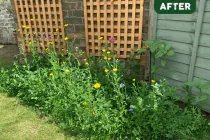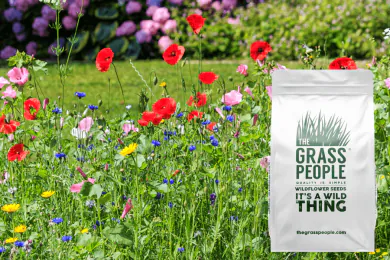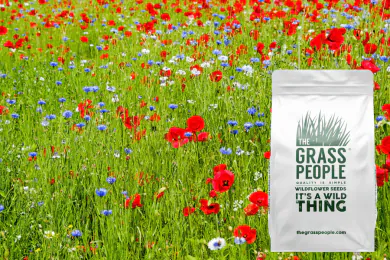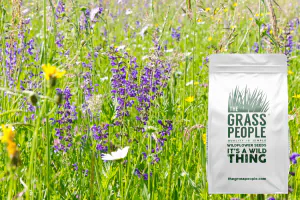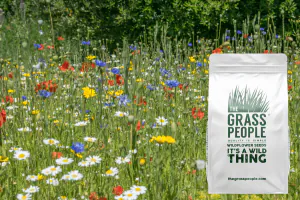Bees & Pollinators Wildflowers
- A vibrant mix of pollinator-perfect flora
- Contains a balanced mix of annuals, perennials and grasses
- Wildflowers expertly picked for their bee attracting abilities
Please refresh the page in 1 minute to see the next delivery time.
How much do I need?
Simply enter the length and width of the area, to calculate how much you need.
Product Description
Our Bees & Pollinators wildflower mix is a bountiful blend of wildflowers recommended on the RHS Plants for Pollinators list. Our team expertly picked each wildflower based on its attracting abilities while still maintaining a mix that is colourful, cohesive and ideal for most soil types.
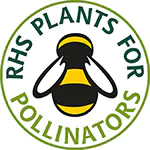
Mixture Breakdown
July - August
What colour is it?Pink / Lilac
Annual or Perennial?Perennial
Latin NameMalva moschata
DescriptionMusk Mallow is a light pink perennial that sits open and welcome for bees to land on. It’s easy to access pollen makes it the ideal flower for attracting bees alongside its sweet musky scent that invites them to pop in for more than just a pit stop!
May / September
What colour is it?Purple / Pink
Annual or Perennial?Perennial
Latin NameTrifolium pratense
DescriptionRed Clover is a popular perennial that despite its name, is actually purple! It's dome-shaped flowers are relatively low-growing which makes it the perfect fodder food for livestock, but is also a fan favourite of weary bees who need a feed a little closer to the ground.
May / September
What colour is it?White / Yellow
Annual or Perennial?Perennial
Latin NameLeucanthemum vulgare
DescriptionImagine the daisy chain these would make! Oxeye Daisy is the largest member of the daisy family and its almost flat surface makes the perfect landing pad for bees and pollinators.
June - September
What colour is it?Yellow
Annual or Perennial?Perennial
Latin NameAgrimonia eupatoria
DescriptionAgrimony is a spikey perennial wildflower with buttercup-like blooms which stems can grow up to 80cm!
April - June
What colour is it?White
Annual or Perennial?Perennial
Latin NameAlliaria petiolate
DescriptionGarlic Mustard is a pretty white perennial that can be typically found in hedgerows and woodland where it thrives in dark and moist soils. If you're wondering how it got Garlic in its name, when its leaves are crushed they smell of it!
June - September
What colour is it?Yellow / Orange
Annual or Perennial?Annual
Latin NameAnthyllis vulneraria
DescriptionKidney Vetch is a bright yellow budding wildflower that sometimes gets the name Woundwort. Although this isn't the nicest nickname, it was once used for treating ailments, and of course - wounds.
June - August
What colour is it?Violet
Annual or Perennial?Annual
Latin NameCentaurea cyanus
DescriptionCornflower was previously considered a weed in amongst its cornfield annuals companions but is now accepted and widely praised as one of its finest! We're not surprised - who could dismiss those electric blue blooms?
May - June
What colour is it?White
Annual or Perennial?Perennial
Latin NameAnthriscus sylvestris
DescriptionCow Parsley is a shade tolerant wildflower that can be found naturally growing in woodland areas and its stem branches out into many clusters of tiny white flowers. It is sometimes referred to as 'Queen Anne's Lace' as it was said it would bloom for Queen Anne and her ladies in waiting and resembled the lace on their dresses.
July - August
What colour is it?Purple
Annual or Perennial?Perennial
Latin NameDipsacus fullonum
DescriptionTeasel when in flower is great at attracting bees as it becomes a dome of small purple petals, with spikey leaves that are handy to land on and hold on to! Whilst this wildflower is great for bees, when it isn’t in bloom it’s also great for birds, in particular Goldfinches who feast on its seeds.
July - September
What colour is it?Purple
Annual or Perennial?Perennial
Latin NameCentaurea Scabiosa
DescriptionGreater Knapweed is the larger relative of Common Knapweed, with distinctly larger flower heads. Just like its smaller sibling, Greater Knapweed is a vital source of food for bees and pollinators.
June - September
What colour is it?Purple
Annual or Perennial?Perennial
Latin NameCentaurea nigra
DescriptionCommon Knapweed can be mistaken for a thistle before it blooms, and once it does, it has magnificent starburst purple petals that resemble a firework display!
April to May
What colour is it?Yellow
Annual or Perennial?Perennial
Latin NamePrimula veris
DescriptionCowslip tends to have dark green and wrinkled leaves that are quite wide and start to narrow towards the end. It has flowers with five petals which are bright yellow in colour. The flowers are surrounded by a green protective casing and grow in bunches on each plant that all face the same direction.
June - October
What colour is it?Yellow
Annual or Perennial?Annual
Latin NameGlebionis segetum
DescriptionCorn Marigold is a bright ray of sunshine on a gloomy day. Its orange-yellow petals burst into life in June and last all the way through until October. Part of the cornfield annuals family, although this annual may have one showing - it’s a showstopper!
May - October
What colour is it?Yellow
Annual or Perennial?Perennial
Latin NameTaraxacum officinale
DescriptionAlthough it may be most people’s worst nightmare, dandelions are a great source of pollen for bees and butterflies alike and shouldn't be overlooked. Providing a pop of colour to your meadow, dandelions are diverse and will grow in most soil conditions.
June – November
What colour is it?White / Occasionally pink
Annual or Perennial?Perennial
Latin NameAchillea millefolium
DescriptionYarrow produces clusters of white small-petalled blooms. It is an aromatic perennial making it particularly attractive to bees and pollinators who are enamoured by its sweet scent.
June - September
What colour is it?Yellow / Purple
Annual or Perennial?Perennial
Latin NameVerbascum nigrum
DescriptionDark Mullein is a very tall wildflower that is used to growing in dry places - so is ideal for sandy soils. We love its large yellow petals and purple centre.
June – September
What colour is it?Pink / Purple
Annual or Perennial?Perennial
Latin NameDigitalis purpurea
DescriptionFoxgloves are biennial wildflowers that when sown will reward you with blooms for two whole years. Their bright pink / purple bells are attractive to bees and pollinators who tunnel in to feed on its nectar.
June - September
What colour is it?White / Yellow
Annual or Perennial?Annual
Latin NameAnthemis arvensis
DescriptionAlthough Corn Chamomile looks like a daisy, it is part of the cornfield annuals family. With its flat and almost-level surface it makes the perfect pit-stop for bees and pollinators.
May-August
What colour is it?Red / Black
Annual or Perennial?Annual
Latin NamePapaver rhoeas
DescriptionCorn Poppy is a vibrant and bright addition to any meadow and easily recognisable and identifiable throughout the UK. Of course it has meaning for many, and also adds a colourful pop to any wildflower plot!
May – September
What colour is it?Purple
Annual or Perennial?Annual
Latin NameAgrostemma githago
DescriptionCorncockle is a pretty purple wildflower with tall stems and full petals and is a bright addition to any annuals mix. It is currently rare and endangered.
June - September
What colour is it?White
Annual or Perennial?Perennial
Latin NameTrifolium repens
DescriptionWhite Clover is a great source of food for bees and pollinators who can enjoy its nectar from a slightly shorter height. Its dome flowers create a pretty globe of white blooms.
May - September
What colour is it?Yellow / Red
Annual or Perennial?Annual
Latin NameLotus corniculatus
DescriptionBirdsfoot Trefoil is part of the pea family and grows up to 35cm. It is well known for its yellow slipper like petals and red centre, which has given it the nickname of 'Eggs and Bacon'!
This is a grass seed and typically germinates at temperatures of 8 -10 degrees.
What colour is it?Green / Beige
Annual or Perennial?Perennial
Latin NameStipa gigantea
DescriptionGolden Oat Grass is a tufted arable grass that performs in most soil types
This is a grass seed and typically germinates at temperatures of 8 -10 degrees
What colour is it?Green / Beige
Annual or Perennial?Perennial
Latin NameAgrostis vinealis
DescriptionBrowntop Bentgrass is a grass that performs in most soil types
This is a grass seed and typically germinates at temperatures of 8 -10 degrees.
What colour is it?Green / Beige
Annual or Perennial?Perennial
Latin NameFestuca ovina
DescriptionSheeps Fescue is a grass that performs in most soil types
This is a grass seed and typically germinates at temperatures of 8 -10 degree
What colour is it?Green / Beige
Annual or Perennial?Perennial
Latin NameFestuca rubra
DescriptionSlender Creeping Red Fescue is a grass that performs in most soil types
This is a grass seed and typically germinates at temperatures of 8 -10 degrees
What colour is it?Green / Beige
Annual or Perennial?Perennial
Latin NameFestuca rubra ssp. Commutata
DescriptionChewing's Fescue is a grass that performs in most soil types
Usage Guide
● Remove any existing grass, plants or flora from the area where you plan to sow your wildflower seed. Failure to do this will produce poor results
● Further remove the top 5-10cm to reduce soil fertility
● Allow the area to cultivate for several weeks, and remove any weeds that may pop in the area during this time
● Do not be tempted to add top soil, compost or fertiliser to the area - wildflowers prefer low nutrient conditions
● After the cultivation period ensure to remove stones or any other debris and rake the area to create a fine, friable and level seedbed
● Scatter the seed at a rate of 5g per m2
● Rake the seed so that it is in amongst the soil
● Water the just-sown wildflower seed well
● If sowing in drought conditions, water as required to keep the area moist in the first 6 weeks after sowing
Read our full guide on how to manage your wildflower meadow here.
| Sowing Rate | 5g per m2 |
| When | For best results sow in March/April or in September |
Aftercare
End of year cut:
- We recommend doing this essential end-of-year cut in autumn.
- Your wildflowers are ready for their first cut when they have grown to 7cm and have gone to seedhead.
- This cut can be done using your lawn mower at its highest setting or using a strimmer.
Early spring cut:
- An early spring cut is ideal when your wildflowers are well-established.
- This early spring cut trims back meadow grasses and helps increase the density of the wildflowers.
- This cut also encourages wildflowers to grow better later that season.
- Cut before the end of April, or you may stunt their growth, and they could skip blooming that year.
Summer cut (optional):
- A cut between June and August can encourage the growth of wildflowers later in the season.
- Cut back to 7cm tall and remove the cuttings.
- This optional cut encourages new wildflowers to grow and flourish.
What to do with the cuttings (if you have annual wildflowers in the mix):
In dry conditions:
- If conditions will be dry for 5-7 days, you can let the cuttings lie on the ground so the seeds drop.
- Walk over, use a roller or shake the seedheads to encourage the seeds to fall and grow next season.
- Then remove the plant cuttings after a week and dispose of them in your garden waste bin.
In wet conditions:
- Lift the clippings if rainfall is forecast, and manually free up the seeds by crushing the seedhead to collect the seeds for replanting.
- When dry conditions return, scatter the seeds across your wildflower area.
- Alternatively, you can store your collected wildflower seeds in an envelope and replant them later.
For further reading, check out our guide on when and how often to cut a wildflower meadow.
The above photo depicts the variety of species you should expect to see in your wildflower display. Please note that certain species within this mix and all our wildflower mixes may become more abundant than others, and this varies based on the conditions in which they are sown. Taking this into consideration, your wildflower meadow will evolve and adapt year after year and change in appearance as certain species may become more dominant than others.
Product Questions
Product Questions
We would not recommend covering the wildflower seedbed with wood bard. If you wish to cover it we would suggest a light coarse grain sand but if they are sown onto a friable seed bed then just raking or treading them into the surface should suffice.
Thank you.
I would also suggest as the weather starts to turn cold again at the end of the year to scarify / abuse the grass a little to give the new seeds some room to grow, if the grass is too well established the flowers will struggle to compete.
I believe we have spoken on the phone before about this. Unfortunately at the moment unless it is a specialised mix we cannot increase the amount of any of the wildflower seeds beyond what we have in the mix - however, we are considering expanding our wildflower range in a way that would allow you to do this in the future. I hope this helps!
Thanks
Autumn and spring are great times to sow wildflower seed. Annuals will appear 60-80 days after sowing, perennials will have a small showing but will take up to one year to fully establish. If you sow in Autumn, you should expect a showing in early spring and if sowing in spring you should see blooms in summer.
No one meadow will look the same as another. This is what makes them so unique!
The success and results of your meadow rely on a number of factors such as weather, soil and available space and this can change from year to year. Annuals will appear one year and not the next whereas the perennials that did not bloom the first will make an appearance the second year.
Depending on the conditions some varieties of wildflower will thrive whilst others will struggle and this is what makes the outcome of a meadow so unpredictable yet exciting.
Annuals typically only have one showing but you can see them again the following year – if you do your prep. Annuals go to seed head each autumn and drop seeds into the soil. They are self-seeding, and almost self-sufficient but unfortunately, their process is not perfect – they need a bit of a helping hand.
You can manually assist this process by putting your mower on a high setting or cutting the wildflowers down. Then use a roller (if you’re fancy!) or your wellies to split the seed heads up to allow more seeds to get into the soil. This will result in an annual showing in the following year.
Oxeye Daisies are small perennials.
I have also included our step-by-step guide on how to prep and sow a wildflower meadow:
1. Remove any existing grass, plants or flora from the area where you plan to sow your wildflower seed. Failure to do this will produce poor results
2. Further, remove the top 5-10cm to reduce soil fertility
3. Allow the area to cultivate for several weeks, and remove any weeds that may pop in the area during this time
4. Do not be tempted to add topsoil, compost or fertiliser to the area - wildflowers prefer low nutrient conditions
5. After the cultivation, period ensure to remove stones or any other debris and rake the area to create a fine, friable and level seedbed
6. Scatter the seed at a rate of 5g per m2
7. Rake the seed so that it is in amongst the soil
8. Water the just-sown wildflower seed well
If sowing in drought conditions, water is required to keep the area moist in the first 6 weeks after sowing.
Thank you for your query. The safeness and suitability of sowing wildflowers in reach of pets largely concerns whether consumption / ingestion of the flowers is of a huge concern.
Wildflowers such as Buttercups and Foxgloves are poisonous to animals and can be to humans, and are present in all of our wildflower mixes. Each of these wildflowers have minor to moderate toxicity and can prove fatal if consumed / ingested in any amount. Therefore, we would not recommend sowing any of our wildflower seed mixes, or any others, near your children or pets if you have concerns that they would consume them.
Animals have intelligent instincts and by using their scent can work out what is and what isn’t poisonous, so there is low risk of them wanting to snack on your wildflowers. However, if your pet or livestock has a penchant for wolfing down wildflowers or any other garden flora it’s best not to put anything in front of them that could potentially harm them.
Thanks
Roisin
